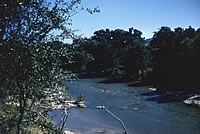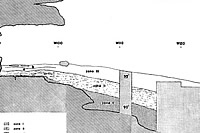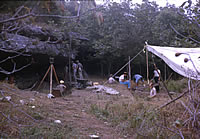Canyon Reservoir Sites
With its sparkling clear waters and abundant wildlife, it is no wonder that the Guadalupe River valley in Comal County was a prime settlement area for native peoples for over 12,000 years. Open campsites, burned rock middens and rockshelters containing archeological remains are all present in the area and date to every cultural period of Texas prehistory.
In 1949 archeologist Robert Stephenson undertook a brief reconnaissance of the section of the Guadalupe River valley that was scheduled to be inundated by the lake known today as Canyon Reservoir. Stephenson worked for the Austin office of the River Basin Surveys, a program of the Smithsonian Institution. At the time there were no laws protecting important historical and archeological resources, yet it was recognized that federally-funded dams would soon inundate hundreds of prime river basins across the nation. The Smithsonian’s program was the first modest attempt to salvage some of the information that would soon be lost. Stephenson was a given a few weeks to search the area and he documented over 35 sites in the reservoir’s flood pool area, a fraction of those that must have been present.
In 1959, a small amount of federal funding became available for salvage excavations at Canyon Reservoir. Archeologists from the Texas Archeological Salvage Project at UT Austin carried out small scale excavations at three of the sites found by Stephenson. These sites were chosen because they had evidence of repeated occupations and intact stratigraphy (layering).
The 1959-1960 Excavations at Oblate Rockshelter (41CM1), Footbridge (41CM2), and Wunderlich (41CM3), yielded nearly 2,400 stone tools from stratified deposits. Due to the poor preservation conditions at these sites, stone tools were about the only artifacts present. While this hindered the broader reconstruction of life at the sites, the large number of projectile points allowed investigators to reconstruct the chronological sequence of projectile points covering 6,000 years of central Texas prehistory. In 1960 archeologists had not yet worked out the basic chronology for the region, or sequence of changing point styles through time.
Using data from Oblate Rockshelter and the Wunderlich site, archeologists LeRoy Johnson and Dee Ann Suhm created four groupings of dart points spanning the then-known extent of Archaic era, each representing a separate major time period. Although these groupings have been refined by later work in the region, the basic sequence of changing styles through time has held up.
The Canyon Reservoir chronology and site excavation details were reported in a 1962 report that represents a milestone in Texas archeology. In the absence of material suitable for radiocarbon dating, projectile point chronologies provide a reliable means for estimating the age of occupations at archeological sites.
In 1963, Dr. E. Mott Davis of the University of Texas led a group of 70 volunteers back to the Oblate site for one week of additional excavation prior to the filling of the reservoir. This event was the second field school of the Texas Archeological Society, an annual training program that has been held every year since.
References
Johnson, LeRoy Jr., Dee Ann Suhm, and Curtis D. Tunnell
Salvage
Archeology of Canyon Reservoir: The Wunderlich, Footbridge, and
Oblate Sites . Texas Memorial Museum, Bulletin No. 5,
Austin.





